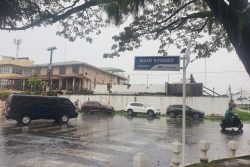With only the Build-Own-Operate-Transfer (BOOT) financial model to be accepted, the government has issued a new Request for Proposal (RFP) for the Amaila Falls Hydro Project (AFHP), and pre-qualification is to be determined on strict experience and commitment to local content.
“The Government of Guyana (GOG) invites revised Request for Proposals (RFP) under a Build-Own-Operate-Transfer (BOOT) model for the Amaila Falls Hydro Project, “ the notice for the RFP published in Saturday’s edition of the Stabroek News stated.
The notice outlines elements of what the proposals should entail; that the project is one to be added to the gas to energy project, which together will provide power generation to the Guyana Power and Light Company. As it relates to transmission, the notice said that the AFHP will integrate and expand the national grid, to include Linden.
When the project was initially conceptualised and was being undertaken by Sithe Global, a subsidiary of Blackstone, the government was prepared to purchase electricity at US 10 cents per kilowatt hour since what was being generated cost twice as much.
The PPP/C had said, during its 2020 campaign, that should it return to office, it would revive the project. And in 2021, it advertised for RFPs.
Then, the government had asked that proposals submitted by prospective developers be made under both the BOOT and Design-Build-Finance (D-B-F) models. The latter model has now been eliminated.
It was explained then that the call for the RFPs was due to the fact that the Guyana Power and Light’s current Development and Expansion (D&E) Plan for 2021 to 2025 projects that the total capacity required in 2025 would be 465 MW and energy of 2,900 GWH.
According to the RFP, the summary of Scope of Works entails a 165 MW installed hydro dam, plant, and related works; transmission line and structures: 270 KM double-circuit 230 KV from Amaila to Sophia; 230 KV Substations in Linden and Sophia; creation of a 23-square-kilometre storage reservoir; upgrades and completion of roads and bridges to the site (85 kilometres new; 122 kilometres existing); and assumption of all geo-technical risks including guarantees relating to the structure of the reservoir, dam, and transmission towers. Under the BOOT model, it asked that firms state the cost/kWh (and equivalent annual payment) for power delivered to Sophia, Georgetown, on the basis of a 20-year BOOT (period starting from commercial operations date), with all of the costs of the project to commissioning date, being borne by the developer, and the project reverting to the government at the end of the BOOT period, at no cost. All appropriate assumptions including cost of capital, equity, debt, and operating costs should be stated, it added.
The hydro project, previously pegged at US$858.1 million, had been the flagship project of the PPP/C government when it was in power pre-2015. However, the then opposition parties, A Partnership for National Unity (APNU) and the Alliance For Change (AFC), had used their combined one-seat majority to halt the project.
When the APNU+AFC government took office in 2015, Vice President Bharrat Jagdeo, who was then the opposition leader, had pleaded to continue a conversation on the project and ensure that it was restarted. However, then Minister of State Joseph Harmon made an announcement in October 2017 that the project had been canned. He had told this newspaper in an exclusive interview that his government was focusing on an energy mix with natural gas as a prime component.
A Norconsult report, which was meant to be a final study of the project and commissioned under the Guyana-Norway partnership, was generally favourable towards the venture but the APNU+AFC government interpreted it differently.
For the submissions received from three Chinese companies, one from China Railway Group Limited (CRGL) had been selected.
But last May, Jagdeo had told a press conference that CRGL was unable to finance the construction of the roughly US$1billion project, and had written to the government requesting that it consider a different model of financing. He said that would have required re-tendering for the controversy-riddled project.
He had said that they were “having a hard time doing the BOOT contract and they want to shift to an EPC [Engineering, Procurement and Construction] plus financing, where the government finances the project and they will be the contractors.”
According to Jagdeo, that suggested method of financing was not at the time possible, since those were not the terms under which the company bid for the project.
“We are still in negotiations. We are still trying to get them to meet the commitment that they had bid for… If we can’t change that, we can’t get it done under the BOOT, we can’t proceed with the company, we will have to re-tender. We will not be able to conclude the contract,” he had said.
Government had been in negotiations since November 2021 and had not been able to make headway for an agreement on the project which has been on and off the agenda for over 15 years.
“The last six months we have been struggling to reach an agreement. We will have to give a deadline and cancel if they can’t proceed with the original model… The tender was about Build-Own-Operate-Transfer, not an EPC plus finance model… so we may have a setback on that,” Jagdeo had said.
He had added that while this would delay plans for the energy sector, the PPP/C government remained committed to ensuring that the cost for energy was reduced by 50%.
Pressed on what difficulties the company had been experiencing, Jagdeo had said, “they simply can’t raise financing.”
Asked if there were considerations to engage the second most competitive bidder, he responded in the negative stating that that bidder proposed a higher retail figure per kilowatt hour – US 9.9 cents.
The current notice says that companies submitting RFPs must adhere to the strict criteria outlined. These include the developer’s capability and credibility to execute the project, both hydro and transmission.
All companies have to agree to a non-disclosure agreement and the government said it will not be bound to any of the responses given.





